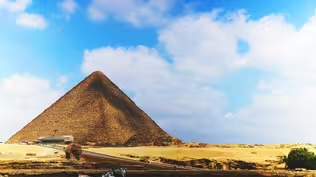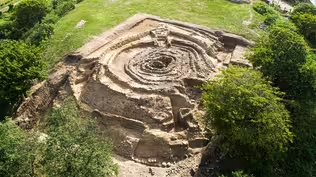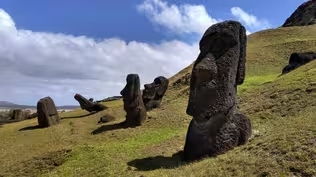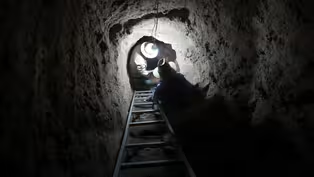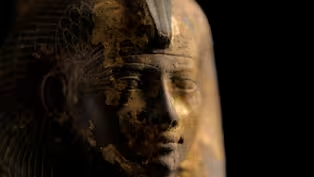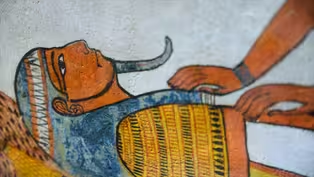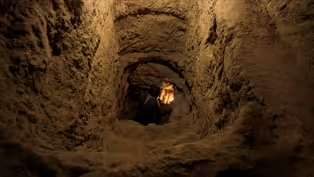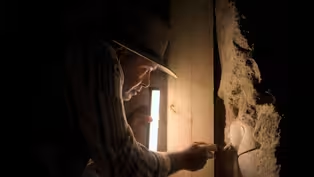
Egypt's Tombs of Amun
Season 52 Episode 4 | 53m 40sVideo has Closed Captions
A long-lost ancient cemetery opens the door to a unique period in Egyptian history.
Follow archaeologists as they discover a long lost ancient cemetery in Egypt’s sacred desert. Treasures emerge unlike anything seen by the team, revealing details of a unique period, when women had extraordinary power.
Problems playing video? | Closed Captioning Feedback
Problems playing video? | Closed Captioning Feedback
National Corporate funding for NOVA is provided by Carlisle Companies. Major funding for NOVA is provided by the NOVA Science Trust, the Corporation for Public Broadcasting, and PBS viewers.

Egypt's Tombs of Amun
Season 52 Episode 4 | 53m 40sVideo has Closed Captions
Follow archaeologists as they discover a long lost ancient cemetery in Egypt’s sacred desert. Treasures emerge unlike anything seen by the team, revealing details of a unique period, when women had extraordinary power.
Problems playing video? | Closed Captioning Feedback
How to Watch NOVA
NOVA is available to stream on pbs.org and the free PBS App, available on iPhone, Apple TV, Android TV, Android smartphones, Amazon Fire TV, Amazon Fire Tablet, Roku, Samsung Smart TV, and Vizio.
Buy Now

NOVA Labs
NOVA Labs is a free digital platform that engages teens and lifelong learners in games and interactives that foster authentic scientific exploration. Participants take part in real-world investigations by visualizing, analyzing, and playing with the same data that scientists use.Providing Support for PBS.org
Learn Moreabout PBS online sponsorship♪ ♪ ♪ ♪ NARRATOR: In Egypt, a team of archaeologists has made an extraordinary discovery.
ZAHI HAWASS: I never thought that anything like this would be discovered.
NARRATOR: A cemetery hidden for millennia.
AFIFI ROHIM: We can see the burial chamber.
NARRATOR: No one knew of its existence.
We are in front of a sealed tomb.
NARRATOR: How many tombs will they find?
This is really exciting.
NARRATOR: What lies within?
ROHIM: We are sure that this tomb intact tomb.
NARRATOR: Now, from the Egyptian desert, incredible artifacts emerge.
HAWASS: Beautiful-- this is the first time I see something like this.
NARRATOR: Who was buried here?
These individuals were wealthy.
NARRATOR: Now these lost tombs are revealing a unique period in Egyptian history, when kings from the south conquered and ruled Egypt and Egyptian women had more power and prestige than ever before.
JULIA BUDKA: The god's wife of Amun was really the female substitute of the king.
MARIAM AYAD: The god's wife of Amun was as important as a medieval pope.
NARRATOR: Who were these outsiders who ruled Egypt?
And how did they help women rise to such heights?
♪ ♪ "Egypt's Tombs of Amun," right now, on "NOVA."
♪ ♪ ♪ ♪ NARRATOR: Ancient Egypt, a civilization that lasted for more than 3,000 years.
From towering pyramids to palatial rock-cut tombs, from sprawling temples to soaring obelisks, its long history is meticulously recorded on the walls of Egyptian temples, colossal statues, and the artifacts the Egyptians buried in their tombs.
Leading the Egyptian people was a succession of about 300 rulers, divided into 31 dynasties lasting from around 3200 to 300 BCE.
These were the pharaohs, who were both heads of state, as well as divine intermediaries between the people and their gods.
Most of the history of Ancient Egypt unfolds over three major periods of unity and prosperity.
The Old Kingdom, the era of the pyramids.
The Middle Kingdom, a classical age, when literature and the arts flourished.
And the New Kingdom, when Egypt extended its control beyond its borders and became an empire.
As well as three periods of instability in between, called the First, Second, and Third Intermediate Periods.
The New Kingdom is probably the best-known period in Ancient Egypt because we have all those temples, we have huge amounts of royal stelar texts and inscriptions.
Egypt was completely connected with the Mediterranean, with the Near East, with the south.
It's really the first evidence for globalization in our history.
♪ ♪ People were living together, people were copying things, they're creating something new.
NARRATOR: The New Kingdom is considered Egypt's golden age, a time of wealth, prosperity, and power.
♪ ♪ Pharaohs like Ramesses II and Hatshepsut build magnificent temples, and incredible treasures, like the ones found in the tomb of Tutankhamun, are produced.
But after nearly 500 years of splendor, things start to change.
There were internal political problems, economic problems, periods of hunger, civil wars.
NARRATOR: During this time of declining prosperity, the state collapses, allowing self-proclaimed regional rulers to grab power and divide the country.
After the fall of the New Kingdom, Egypt fell into a dark, dark, dark age of political fragmentation.
It's known as the Third Intermediate Period.
NARRATOR: Starting in 1069 BCE, the Third Intermediate Period lasts for more than 300 years.
The archaeological record from this period of Egyptian history is fragmented.
The story of the people who lived during these times is largely unknown.
But now new information is being uncovered 400 miles south of Cairo, in an excavation happening in Egypt's richest archaeological area: Luxor.
BUDKA: The modern city of Luxor was the ancient Thebes, and for centuries, it was the religious capital of Egypt.
NARRATOR: Some of the most famous ancient sites are here: temples to the most important gods on the East Bank of the Nile; the funerary temples of the pharaohs and the vast Necropolis, or city of the dead, to the west.
The popular belief is, we know already everything.
We have deciphered the hieroglyphs.
We have so many temples and tombs.
We know what happened.
This is actually not the case.
And every single archaeological dig can teach you a lot.
NARRATOR: In September 2020, a team of Egyptian archaeologists led by Zahi Hawass started excavating a new site there, on the West Bank of the Nile, and discovered a long-lost city.
We discovered one house, and this house led us to this major important discovery.
The lost golden city.
NARRATOR: Built by Tutankhamun's grandfather Amenhotep III in the 14th century BCE, the lost city is a sprawling maze of serpentine walls, houses, workshops, and administration buildings.
For centuries, no one knew of its existence.
The lost city is built on prime ancient real estate in the area known as Medinet Habu on the West Bank of the ancient city of Thebes.
It took the archaeologists nearly two years to fully excavate it.
HAWASS: When we found the lost golden city, I really wanted to extend the area in the north.
This is known in the map as the Triangle.
This area is empty-- no one really ever excavated it.
NARRATOR: For decades, it's been just a patch of desert next to the main tourist route.
Every morning, dozens of buses whiz past on their way to the famous sites.
Hundreds of tourists take to the sky on hot air balloons.
It would seem an unlikely place for a big discovery.
♪ ♪ In September 2022, two years after the lost city was discovered, the team starts excavating the Triangle.
As soon as the archaeologists remove the first layer of sand, they uncover mud bricks-- evidence that there might be more to be found.
Zahi decides to concentrate the team's efforts in this area.
Within days, they uncover a row of large pottery vessels.
Remarkably, they are still sealed.
As they open one, they are about to find something very telling: a clear indication of what this site once was.
Huh.
What's this?
It's kind of plants.
NARRATOR: The plants appear to have been burned.
What's this?
ROHIM: Linen.
Linen?
And we will take all the filling outside to be sure what's behind this.
HAWASS: Oh!
Broken pottery!
This is a ritual.
NARRATOR: The contents of the pots all relate to a funerary ritual.
BUDKA: During mummification, the embalming workshops produced leftovers that was regarded as something important.
They were not just put somewhere as trash, but they were arranged in deposits.
Sometimes they deposited linen, organic remains, botanical remains.
Very often, we find broken pots inside the vessels.
And this is what in general we call embalming cache.
NARRATOR: An embalming cache is the collection of the precious leftovers of materials used during the mummification process.
BUDKA: Finding a cache of embalming material tells you immediately that you have found something associated with a cemetery.
And you should probably look for a tomb nearby.
NARRATOR: This is a momentous find.
♪ ♪ Is the team on the verge of a new important discovery?
(people talking in background) Excited, they split into groups, each tackling a different corner of the Triangle.
Soon, they uncover evidence of several tombs.
The archaeologists are standing on a previously unknown burial ground.
It's not every day that you find a brand-new cemetery.
So this is really exciting.
NARRATOR: When was this cemetery built?
And who was buried here?
HAWASS: Work in this big, large cemetery, it's a challenge.
It needs to be excavated completely to understand the date.
The excavation will give us more information about the people who are buried in this large cemetery.
BUDKA: The burials are located on the West Bank, because in the Egyptian concept of the netherworld, the entrance to the netherworld is on the west.
The sun rises in the east and sets in the west, and this is what a human life should repeat.
♪ ♪ NARRATOR: The Ancient Egyptians invested vast amounts of wealth and energy preparing for life after death.
The belief of the afterlife built Egypt.
That belief made the Egyptian to build pyramids, tombs, and temples.
NARRATOR: They believed that life continued after death, and the tomb was considered the house for eternity.
For those who could afford it, the mummified body would have laid to rest inside beautifully decorated tombs.
BUDKA: There's the popular belief that the Ancient Egyptians were obsessed by death, and that they were only caring about life in the netherworld.
This is, of course, definitely not the case.
The Egyptians were people like us, so they wanted to live.
Mortuary rituals is actually something that helps the living to overcome, um, their sorrow, their grief.
♪ ♪ What you find in tombs tells you so much about society and about the living.
♪ ♪ NARRATOR: Tombs are time capsules that can preserve information about ancient people for millennia.
HAWASS: You can gain a lot of knowledge and information about burials, and that's why this cemetery needs more excavation.
NARRATOR: The tombs in the Triangle are all different.
Some have a shaft dug straight into the ground.
And at the bottom, they open up to the burial chamber.
Some have grand entrances, complete with a staircase, and more than one room carved into the rock.
Archaeology is dangerous for archaeologists.
♪ ♪ It's hard work.
(man grunts, people talking in background) It's to live dangerously.
But to live dangerously, it's fun, also.
It's amazing when you make a new, important discovery.
♪ ♪ You completely forget dangers.
Archaeology is like a box of chocolate.
What is this?
You never know what you get.
Looks like part of a necklet.
NARRATOR: Four months into the excavation, and the archaeologists haven't found any mummies yet.
But intriguing artifacts emerge from the tombs.
ROHIM: Here I found a metal eye used in wooden coffins.
Wow!
NARRATOR: A gold ring with a carved carnelian.
Amulets believed to protect the deceased with their magical powers.
And shabtis, images of the tomb owner, who the ancient Egyptians believed did all the manual labor in the netherworld.
With only one month left before desert temperatures rise and work must stop, site director Afifi Rohim starts working in tomb number six, one that he finds most promising.
The cut in the mountain is very good.
We have a staircase and we have this corridor.
Till now, most of the debris is still original debris.
Mm.
(speaking Arabic) (Ahmed El Nasseh speaking Arabic) ROHIM: (Baghdadi speaking Arabic) ROHIM: Mm.
(others speaking Arabic) ROHIM: BAGHDADI: ROHIM: BAGHDADI: ROHIM: Mm.
NARRATOR: Most tombs discovered in Egypt have been looted in antiquity.
If there are no objects mixed in the sand, it could mean two things: either the tomb is unfinished or no one has entered it since it was sealed thousands of years ago.
HAWASS: There is no tomb that could be looted if, in a shaft, you have clean sand.
NARRATOR: This is tantalizing evidence that tomb number six might be intact.
The workers remove bucket after bucket of sand.
♪ ♪ Then, suddenly, the density of the sediment changes.
ROHIM: He start to find very compact layer.
Looks like mother rock.
And this means that all this layer was the original layer, which, in the ancient time, they make it the filling for the shaft.
If it is, it will be really untouch.
NARRATOR: What drives archaeologists to endure the hot desert environment is the promise of revealing long-forgotten histories and, sometimes, the chance to come face to face with an Ancient Egyptian.
In tomb number six, skilled worker Baghdadi is getting closer to the bottom of the shaft.
For archaeologist Ahmed El Nasseh, this tomb is puzzling.
EL NASSEH: We are still confused because we have natural layers, the compact layer, similar to the bedrock, and below, we have sandy layer, which is loose.
We will follow the bedrock to find the limit of the burial shaft.
(Baghdadi and El Nasseh speaking Arabic) EL NASSEH: He found mudbrick, so, I think we are in front of the blocked doorway.
♪ ♪ NARRATOR: It's exciting news.
There's a good chance the burial chamber has not been opened since it was originally sealed with mudbrick thousands of years ago.
Good news at the end of the day.
♪ ♪ NARRATOR: The following day at the excavation site, it all looks like a normal morning.
But just below the surface in tomb number six, the expectations are high.
Afifi is checking the mudbricks that block the entrance to the burial chamber.
ROHIM: The seal of the doorway is just directly under the mother rock.
It means that it, it never open before.
This tomb was confusing for us.
In the beginning, we thought there's nothing here.
Was thinking that, stop the work and leave the shaft.
NARRATOR: And Afifi is also concerned about the safety of the crew working in the tomb.
The mother rock is not straight, so I try to check if it is still in original situ or just fall down.
NARRATOR: On closer inspection, Afifi notices that a couple of the mudbricks have collapsed under the weight of the rock above, leaving a small opening.
Over time, the sand has seeped through.
With great anticipation, Baghdadi starts removing the mudbricks.
Once the passage is cleared, work inside the chamber begins.
At first, it's just clean sand.
But soon, artifacts emerge.
HAWASS: Is this amethyst?
Huh?
ROHIM: Yeah, could be.
Oh, oh!
Beautiful vase-- God!
(chuckles) Hm.
This is not Egyptian.
This is so strange.
Doesn't looks Egyptian-- even the colors.
NARRATOR: The style of this tiny pot is nothing like any artifact the team has found before.
Was it imported from a distant land?
HAWASS: This is a very important discovery.
The artifacts are now really unique.
Very happy.
NARRATOR: Then Zahi comes face to face with a special object.
HAWASS (speaking Arabic): This is the first time I see something like this.
The lady is seated, having a gazelle on her hand and holding her son on the back.
Can you hold this?
This is another one.
She is standing, and on her back, she is holding a child.
This could be someone from outside Egypt.
NARRATOR: The statuettes confirm Zahi's hunch.
The style of the artifacts is not traditionally Egyptian.
The depiction of the face hints at people originating from beyond Egypt's borders.
And then there's the speckled texture.
The distinctive spotted look, combined with the shapely woman's frame, was only produced during a crucial moment in the history of Egypt, when the country is ruled by foreigners: the 11th century BCE, the start of the unstable Third Intermediate Period.
Egypt had economic problems, only very short-lived kings, quarrels about the inheritance of the throne.
Egypt was vulnerable.
NARRATOR: But this changes when Egypt's southern neighbors, the Kushites-- also known as the Nubians-- take advantage of Egypt's weakness, and, in 712 BCE, they move in and conquer the Land of the Pharaohs.
We refer to the Kushites as the kings of the XXV dynasty.
And this dynasty was originally coming from modern Sudan.
NARRATOR: Known for rich deposits of gold, Nubia is home to some of Africa's earliest kingdoms.
The Egyptians first called Nubia Ta-Seti, the Land of the Bow, highlighting the skill of Nubian warriors.
BUDKA: When the Kushites invaded Egypt, they erected a very, very powerful and very successful empire for roughly 70, 80 years.
AYAD: The Nubians were restorers.
After things were destroyed and the temples were neglected, the Nubians were now going to take care of everything, put everything back in order.
NARRATOR: Egypt is prosperous again.
♪ ♪ BUDKA: They made themselves kings of both Egypt and Kush.
The Egyptian culture was part of their own heritage, because, in the New Kingdom, Nubia was an Egyptian colony.
NARRATOR: Few written records or artifacts of the people that lived under Kushite rule in Egypt survive today.
Which makes what the team is unearthing in the Triangle especially rare.
(speaking Arabic): I really could not believe that statues like this could exist.
It's unique.
The color.
They are very realistic.
NARRATOR: Not only do the two statuettes both show a woman, but some of the small pots that have been found are for makeup.
This tomb for sure belonged this woman.
NARRATOR: Women in Ancient Egypt have the right to buy and inherit property.
They can represent themselves in court, own a business, and get divorced.
But it isn't exactly an egalitarian society.
BUDKA: There was a small percentage of women who were highly privileged, but nevertheless, there was a gender bias in Ancient Egypt.
This is why I think it's not fair to say it's a paradise for women in the ancient world.
NARRATOR: But when the Kushites take over Egypt, they bring with them a Nubian culture in which women have power.
In the Kushite time, women had a different status than before and after.
There is a matrilineal system for the Kushite kingdom.
It was more important who was your mother than who was your father.
And this might be the main difference between Egypt and Kush.
♪ ♪ NARRATOR: Mariam Ayad has spent her entire career studying Ancient Egyptian women, and especially the women of the XXV dynasty.
Zahi has invited Mariam to see the objects found in tomb number six.
HAWASS: This tomb was really unique.
We found some very impressive artifacts.
If you look at the face... AYAD: Yeah?
...it looks Nubian to me.
It does look Nubian, for sure.
This body type of the standing woman... Yeah.
That body type we find a lot during the XXV dynasty.
Yes.
The heavier lower body, the heavier hips.
I have never seen statues like this.
I don't think there's ever statues of that type ever produced before or possibly even after.
♪ ♪ NARRATOR: When the Kushites conquer Egypt around 700 BCE, they decide to embrace the Egyptians' religious customs and beliefs.
BUDKA: In Ancient Egypt, we cannot separate kingship from religion.
Pharaohs invested so much in the religious landscape of Thebes.
NARRATOR: And this strategy is best seen at Karnak, a vast temple complex where pharaohs dedicated great building projects to Amun, the king of the gods.
♪ ♪ When the Kushite kings arrive, they, too, make their marks here.
One of the monuments, built by Kushite king Taharqa, reveals a new and distinctive level of power for women in Egypt.
AYAD: We're here by the edifice of Taharqa at the sacred lake.
We can't call it the temple, because it doesn't have some of the main features we associate with temples.
The only part of the building that survives is the subterranean chambers.
NARRATOR: What's special about this monument is a relief on a wall hidden from view.
AYAD: And because there's no proper entrance, we'll have to climb up.
It's a part of the building with ritual scenes that are unique and not found elsewhere.
NARRATOR: The scene Mariam is looking for is one-of-a-kind.
It depicts two figures protecting a sacred tomb.
AYAD: On either side, the figures are facing outward as a way of protecting it.
In Egyptian art, it's very rare for figures to be facing outward and not toward the center.
The king is throwing four balls, and he's aiming at four targets-- east, west, north, and south.
NARRATOR: Opposite the king, a female figure.
AYAD: She is complementing his actions, asserting the royal dominion over the four extremities of the Earth.
She is drawing an arrow through a double-arched bow, and this is very rare, to find a woman actively arching.
Very rare.
Even the goddess Neith, who's known as the goddess of war, and who's often called the mistress of bow and arrows, she's mostly holding them in her hand.
As far as Egyptian iconography is concerned, this is a unique representation of female power.
NARRATOR: Who is this woman?
Her title is god's wife of Amun.
To understand how a woman might attain such power in Egypt, we need to go back 800 years, when the title of god's wife of Amun first appears.
Carved on a stone slab, or stela, is the title's earliest evidence.
This is the Ahmose Nefertari's donation stela.
Ahmose Nefertari was the wife of King Ahmose, the founder of the XVIII dynasty.
As part of his larger state policy to put trusted family members in key positions around the realm, she was appointed as the god's wife of Amun.
As far as we know, she's the first woman to hold that title.
NARRATOR: With this stela, King Ahmose establishes the estate of the god's wife as a source of revenue for his queen.
The stela records large amounts of gold, silver, and copper, as well as servants and land.
AYAD: On the donation stela of Ahmose Nefertari, there is a very telling line.
It says, "No future king shall ever revoke the estate of the god's wife of Amun."
NARRATOR: With this line, Ahmose makes sure that this newly established estate will last in perpetuity.
AYAD: The women who held that title remained financially independent, and it seems plausible to suggest that it's because of that initial endowment.
NARRATOR: Although the title of god's wife of Amun first appears during the New Kingdom, over time, the position becomes less relevant.
But then, during the Kushites' reign, this role takes on a completely new and powerful meaning.
AYAD: When the Nubians invaded Egypt, they were quick to recognize the political value of having that institution.
The office was resurrected after centuries of oblivion.
So Amenirdis I becomes the first Nubian woman to become a god's wife of Amun.
NARRATOR: The Kushite princess Amenirdis is the sister of Pianky, the first king of the XXV dynasty.
On becoming the god's wife of Amun, Amenirdis effectively takes control of Thebes.
AYAD: Her installation served to achieve a smooth transition of power from the preceding dynasty to the Nubian rule in Egypt.
♪ ♪ Amenirdis participated in rituals that no other woman was allowed to participate in before.
BUDKA: In the XXV dynasty, the god's wife of Amun was much more important than in previous times.
The god's wife of Amun was the female substitute of the king.
AYAD: The god's wife of Amun was as important as a medieval pope in terms of the temporal and religious power that she held.
NARRATOR: In a side corridor at the Cairo Museum, a statue found in Karnak Temple reveals how much power the god's wife of Amun, Amenirdis, really had.
It's carved from alabaster, a soft, translucent form of gypsum rock.
(sighs) The one and only Amenirdis I, royal princess.
It's not very common to find statues of that size in alabaster.
She looks exactly like an Egyptian queen.
The headdress, the modius crown on her head, but she has that pendant of Amun, and that might be a Nubian feature.
On the back pillar, she asserts her moral character.
She gave bread to the hungry, water to the thirsty, and clothes to the naked.
Now, this is significant, because if you are giving food to the hungry, water to the thirsty, you have agency.
It's not just about generosity, it's also about having the means to do so and having the autonomy to do so, and to have a woman have that kind of inscription is very rare.
NARRATOR: Back at the site, the statuettes from tomb number six signal a burial of the XXV dynasty, the period when Amenirdis was the god's wife of Amun.
♪ ♪ Now archaeologists are on the hunt for more clues that might reveal the identity of the woman buried in tomb number six.
But the excavation season is coming to an end.
With summer approaching, the soaring temperatures would make work in the tombs impossible.
♪ ♪ With only a couple of weeks left, Afifi has found a vessel.
ROHIM: We found one of the canopic jars.
It's from fine limestone.
And even the sculpture of the face is, is so good.
NARRATOR: During the mummification process, the organs of the deceased would be removed and placed in these containers.
They are known as canopic jars.
ROHIM: Each burial have four canopic jars-- four organs of the deceased.
NARRATOR: Each jar is topped with a different symbolic sculpture.
The heads represent the four sons of the god Horus.
Each was responsible for protecting a particular organ: the jackal for the stomach, the human head for the liver, the baboon for the lungs, and the falcon for the intestines.
ROHIM: It's empty.
NARRATOR: Afifi is looking for any inscription which could give us the name of the owner of this tomb.
Just behind the first jar, a second one appears.
I want to take the body first.
Oh!
It's nice inscriptions.
Yes, yes.
I am not specialist in Ancient Egyptian language, but I can read, "Osir... ...djer," or, "djerek saa."
Mean something related to Osir.
NARRATOR: The inscription is a prayer to the god Osiris, ruler of the underworld.
I see the base of the lid.
It's complete.
No cracks-- nothing.
It's baboon.
(blows out) Now we have to consolidate the writing.
NARRATOR: The jars have been hiding in the tomb for nearly 3,000 years.
Before they can be taken out, conservator Seham Abdelazeim needs to carefully protect this ancient writing with a water-soluble cellulose binder.
The jars don't reveal the name of the deceased, but Afifi believes there are more artifacts waiting to be found.
But before he continues to excavate, he needs to secure the tomb.
This layers of sediments is, is not strong and it is not safe for working, especially when you open it and the fresh air gets inside.
So it's decayed, and start to dry and fall down.
So we need to make all this support and, to continue our work.
♪ ♪ NARRATOR: The excavation season has come to an end.
The workers prepare supports in an effort to secure tomb number six.
Once ready, Afifi locks it with a metal gate.
The team needs to wait until September, when the excavation will resume.
♪ ♪ When you discover something interesting, you can feel happy.
Of course, I have to be more patient, and...
When we stop excavation in the site, doesn't mean that the work stop.
Because we continue working, in writing the general report, make analysis for the object, and still thinking about the future season.
♪ ♪ NARRATOR: Five months later, the heat has come and gone.
The archaeologists return to the excavation site, eager to pick up the work from where they left it.
♪ ♪ As Afifi and Ahmed reenter tomb number six, something does not look right.
ROHIM (speaking Arabic): EL NASSEH (speaking Arabic): ROHIM: ROHIM: All the tomb collapsed.
All the roof collapsed.
And there are cracks everywhere inside the tomb.
NARRATOR: The ground above has caved in, filling the deep shaft that the team spent days excavating.
And now, it's too dangerous to clear the debris.
I think we lost this tomb.
We can't remove the debris.
We can't even just get inside to check it, because the cracks in the roof and the walls everywhere.
It's not safe for the workers and for my team, and this is our job in archaeology.
Nothing to do.
Moving to the next stop.
(speaking Arabic): NARRATOR: With sadness, the team has to give up on ever finding the woman who was buried here.
She will likely remain in her tomb for eternity, just as she originally planned.
The Ancient Egyptians recorded everything, especially on their burial goods.
Thousands of years later, the archaeologists are on the hunt for clues that might reveal details of long-lost lives.
♪ ♪ At the southern edge of the Triangle, in tomb number nine, the archaeologists haven't found any mummies.
But sunk into the floor of the burial chamber, the lids of four canopic jars appear.
ROHIM: We found this set of four canopic jars here, underneath the floor.
I have to take it out.
NARRATOR: Afifi examines the vessel in the hope it will reveal the name of the person who was buried here.
There is no text, just black decoration.
Something strange for me-- the body is made from alabaster, but the head from limestone.
NARRATOR: He carefully removes the second jar.
Oh, it's different.
It's made of alabaster, but it has a stand made of limestone.
It's rare to find canopic jar with a stone stand like this.
And I think it has some inscriptions.
NARRATOR: The inscription is lightly carved, but since alabaster is translucent, Afifi tries to read it using a small light.
I can read the text now.
"Djet medu Duamutef."
It means "offering to Duamutef," one of four son of Horus.
"Satirdis."
Her name is Satirdis.
So it's for a woman, and she was a female singer in Amun house.
NARRATOR: Finally, the team has a name for the owner of the tomb: Asetirdis, the singer, or chantress, in the Temple of Amun.
AYAD: The god's wife had chantresses in her entourage.
Chantresses were very prominent in Theban society.
In temple ritual, we would see women chantresses making music to the gods.
It makes a lot of sense that chantresses in the House of Amun would be buried just outside the temple at Medinet Habu, because that was thought to be the place of the primeval mound.
NARRATOR: In Egyptian mythology, the primeval mound was the first piece of land to emerge from the watery chaos-- where life was first created.
AYAD: The god Amun would come across the river aged, tired.
He comes back to this primeval place, where he would commune with eight primeval gods.
He would go back rejuvenated and youthful again.
NARRATOR: The tombs in the Triangle are located on this sacred land.
The people buried here could have a close connection to the god Amun.
The people who are buried here could be working in this great institution, the office of the god's wife of Amun.
♪ ♪ NARRATOR: And in the heart of this holy place, the god's wife, Amenirdis, has her own funerary chapel.
AYAD: We are at the great temple of Medinet Habu, and everyone knows it for the funerary temple of Ramesses III, and they walk just straight past this wonderful chapel of Amenirdis.
Even though the façade itself has wonderful inscriptions, no one ever stops to look at them.
Here we have Amenirdis offering Maat, which is the concept of truth and harmony and global order, to Amun and his divine consort, Mut.
This representation is unique for a woman.
It's unique because it's the prerogative of the king only, who is seen as the ultimate preserver of Maat.
And we don't see that any time before that period.
NARRATOR: In the XXV dynasty, the god's wife of Amun has a much more active and visible role than ever before.
Only the king can build on sacred land, so the fact that Amenirdis has a large stone monument here is meaningful.
AYAD: Construction of funerary chapels, any kind of temple, is the royal prerogative, and only the king could do that, but repeatedly, we see the god's wife erect chapels on their own.
To anyone, even those who could not read, the iconography itself told any bystander that these women were as important as the king.
NARRATOR: And historians believe that this level of prestige for women was only attained when the Kushites from Nubia ruled Egypt.
BUDKA: I believe we have a certain difference in the importance of women during the XXV dynasty, because they were just importing their role from Kush to Egypt.
The role of women was different in the Kushite culture.
The royal women had much power, and part of this was imported to Egypt.
I don't think it's a coincidence that this office of the god's wife really flourished under foreign rule.
NARRATOR: Since excavation began in the Triangle, the team has uncovered several tombs.
One has an impressive wide staircase.
With a large quantity of debris removed, the archaeologists can now access the burial chamber.
We remove all the debris from the room itself until we found a group of coffins.
NARRATOR: The human remains are in a very bad state of preservation, the mummy wrappings and wooden coffins completely decayed.
Only the bones of these individuals survive.
EL NASSEH: Maybe it's a family tomb, and now we are working to find some object dating this tomb, like canopic jars with the titles and the name of the owner.
NARRATOR: Skilled excavator Badawi carefully works around one of the coffins.
Soon, the top of a canopic jar appears.
HAWASS: The canopic jars have some inscriptions.
It needs to be clear more.
We still have to look for the other three.
(speaking Arabic): ♪ ♪ NARRATOR: A second jar.
♪ ♪ And soon a third.
HAWASS: Beautiful!
This person has to be elite, an important person.
It's really well done, modeled.
The workshop that made this canopic jars are really perfect.
NARRATOR: And finally, on the fourth and last jar, the name of the owner can be read.
This is the name of him.
ROHIM: His name is Mere.
The name Mere Ren-Amun, the singer of the god Amun.
This is really wonderful.
This person was part of this important office.
Those people, one day, were working, singing, dancing behind the great god's wife of Amun.
NARRATOR: But the style of the canopic jars is different from the others found in the Triangle.
HAWASS: As an archaeologist, you can look at canopic jars and know the period exactly.
The modeling of the faces show 500 BC, the XXVI dynasty.
Through the archaeological evidence, you can say that the big large cemetery, it started in the north, in dynasty XXV, continued to the edge of the city, known as the golden lost city.
The tombs here dated to dynasty XXVI.
NARRATOR: When Mere was alive, the Kushites of Nubia were no longer ruling Egypt, yet he is buried next to the people of the XXV dynasty.
AYAD: For the Theban elites, this was a good burial ground.
It mattered very little who the ruling king was and from which dynasty.
Between the XXV dynasty and the XXVI dynasty in Thebes, there is no material break.
It's a continuous move from the one dynasty to the other.
AYAD: The Theban people are Theban people, so there are generations of the same families living under different kings.
NARRATOR: The reign of the XXV dynasty ends around 653 BCE.
The new royal family that establishes the XXVI dynasty comes from the north of Egypt, from a city called Sais.
But a new king doesn't mean that everything changes.
AYAD: The transition from the XXV to the XXVI dynasty is very interesting.
We have someone like Montuemhat, who was really a man for all seasons.
He was already the mayor of Thebes under the Nubian rulers, he continued to be the mayor of Thebes under the new rulers, and all the while, he took part in the transition in the office of the god's wife, helping establish the new god's wife in place.
NARRATOR: A new pharaoh.
A new god's wife of Amun.
And the people associated with this office keep Medinet Habu as their chosen burial ground.
BUDKA: The title god's wife of Amun lasts until the end of the XXVI dynasty.
AYAD: At the end of that time, Egypt is invaded by the Persians.
And everything changes.
NARRATOR: After the Persian invasion, evidence of the god's wife of Amun disappears.
Lasting for more than a millennium, the title of god's wife of Amun was created in the XVIII dynasty.
But it's 800 years later, in the XXV dynasty, with the help of the Kushite pharaohs from Nubia, that the institution reaches its zenith, Amenirdis's legacy forever imprinted on the artifacts and monuments she left behind.
The archaeologists have unearthed buried treasures of a very special period of Egyptian history, when the Kushite pharaohs of the XXV dynasty rose to power and wrote a new chapter into this rich civilization.
They embraced Egyptian culture and beliefs, but also brought elements of their own culture, where women were financially independent and the power of the god's wife of Amun rivaled that of the king.
AYAD: The god's wife of Amun is very inspiring and empowering to modern women today.
The fact that they're not as well known to the public as Cleopatra or Nefertiti is just the sad reality of modern pop culture.
♪ ♪ HAWASS: A unique cemetery to bring more information about this period.
Oh!
We are making history.
NARRATOR: Like the shifting sands of the desert, history is never static.
It is a quest for understanding who we are, where we've been, and where we're going.
AYAD: People looking at us from even 200 years from now, or 2,000 years from now, how they perceive women today is dependent on how much evidence do we leave behind.
♪ ♪ ♪ ♪ ♪ ♪ ♪ ♪ ♪ ♪ ♪ ♪ ♪ ♪
Video has Closed Captions
Preview: S52 Ep4 | 30s | A long lost ancient cemetery opens the door to a unique period in Egyptian history. (30s)
The God’s Wife of Amun: Powerful Women in Ancient Egypt
Video has Closed Captions
Clip: S52 Ep4 | 3m 3s | Discover a time in Ancient Egypt when women held a role with extraordinary power. (3m 3s)
How the Afterlife Shaped Ancient Egypt
Video has Closed Captions
Clip: S52 Ep4 | 1m 15s | Discover why the ancient Egyptians invested so much in life after death. (1m 15s)
Opening a Sealed Egyptian Tomb
Video has Closed Captions
Clip: S52 Ep4 | 2m 38s | Archaeologists remove the mud brick seal of an unopened Egyptian tomb. (2m 38s)
What's Inside These Ancient Egyptian Jars?
Video has Closed Captions
Clip: S52 Ep4 | 1m 58s | A nearly 3,000-year-old canopic jar is discovered in an Egyptian tomb. (1m 58s)
Providing Support for PBS.org
Learn Moreabout PBS online sponsorship
- Science and Nature

Capturing the splendor of the natural world, from the African plains to the Antarctic ice.













Support for PBS provided by:
National Corporate funding for NOVA is provided by Carlisle Companies. Major funding for NOVA is provided by the NOVA Science Trust, the Corporation for Public Broadcasting, and PBS viewers.


